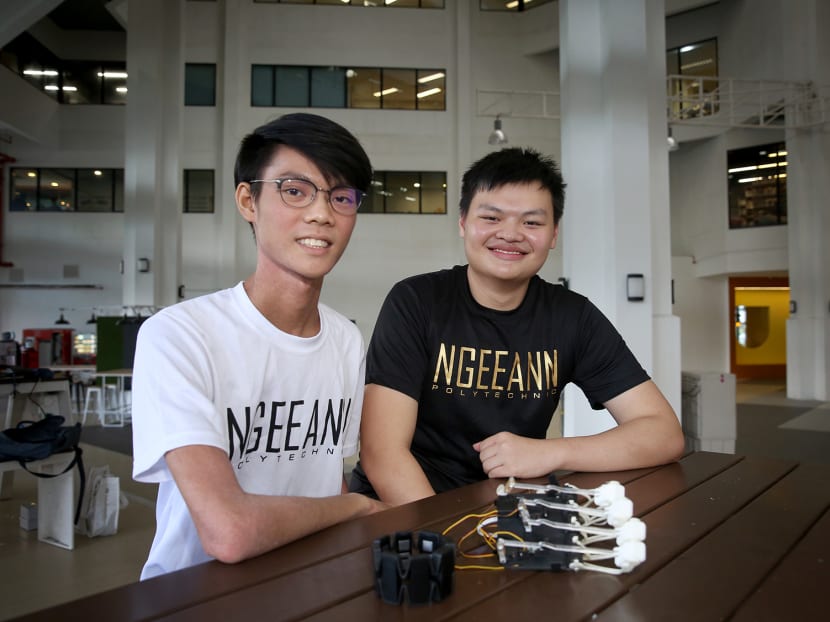Poly students create low-cost, gesture-controlled rehabilitative glove for stroke patients
SINGAPORE — The challenge: Create an assistive, rehabilitative technology for stroke patients.

Ngee Ann Polytechnic students Ho Soon Yee (left) and Joshua Tan, from the Diploma in Engineering Science course, designed a glove to help stroke victims relearn how to grasp their hands.
SINGAPORE — The challenge: To create an assistive, rehabilitative technology for stroke patients.
Spurred on by their lecturer, two 19-year-old Ngee Ann Polytechnic students designed a portable, low-cost, muscle-activated glove to help stroke victims relearn how to grasp their hands — an ability they might have lost as a result of the disease.
The glove, dubbed Grab Now, can be operated by an individual with the help of a commercially available gesture-control armband.
One of the creators, Ho Soon Yee, explained that repetitive hand movements can help the brain rewire neurological pathways to the body’s motor functions, and make them relearn movement.
His co-creator is Joshua Tan, his final-year schoolmate in the engineering science diploma course.
The idea for the glove was germinated by their mentor during the second year of their course’s research and development module.
Mr Ong Teck Soon, an aerospace electronics lecturer, talked about doing something for stroke patients in Singapore, which they thought was a worthwhile cause to take up.
Concerned about Singapore’s ageing population and the higher risk of suffering from a stroke for elders, Mr Ong challenged the students to create something that would be readily accessible and affordable for patients.
“For patients who need to travel far to get to a rehab centre… they might go maybe once or twice before they start to find it bothersome and forget about attending the sessions altogether,” Mr Ong said.
Soon Yee and Joshua spent the next 10 months working on more than 20 versions of the glove before coming out with the final proof of concept, which they presented as their final-year project in September last year.
There are similar concepts available on the market now, such as a S$34,000 device called Hand of Hope as reported by the South China Morning Post, but they are pricey or can only be used within rehabilitation centres. Others are resistive training devices that will not be practical for stroke patients who cannot even move their hands, Soon Yee said.
.embed-container { position: relative; padding-bottom: 56.25%; height: 0; overflow: hidden; max-width: 100%; } .embed-container iframe, .embed-container object, .embed-container embed { position: absolute; top: 0; left: 0; width: 100%; height: 100%; }HOW THE GLOVE WORKS
The glove was created for under S$600 and weighs around 200g, excluding the USB powerbank that keeps it running.
In building it, besides a 3D printed glove, other components include store-bought motors, a Raspberry Pi 3A processor and a MYO gesture-control armband.
“With a bit of effort and good instructions”, Soon Yee said that it is even possible for people who are not tech-savvy to use the design to print their own Grab Now gloves.
Explaining how it works, the duo said that they reconfigured the gesture-control armband to “detect muscle electrical signals and activity” when it is worn on an individual’s upper forearm. That information is then relayed via Bluetooth to the microprocessor, which in turn controls the mechanism for the glove’s individual fingers to create grasping motions.
In layman terms, when the wearer moves his fingers, the glove responds in kind.
If needed, the armband can be recalibrated to be worn by someone other than the patient, such as the caregiver.
Joshua said: “In most cases, family members will just take the patient to the rehab centre. But with this glove, they can participate in this person’s rehabilitation and bond with the patient."
NOT A PROSTHETIC
The pair stressed that the glove is not meant to be a prosthetic, though they are confident that they can reconfigure it to be one, once they learn the relevant biomedical topics.
While they are satisfied that their idea came to fruition, Joshua believes that there is still room to refine the glove both in terms of functionality and aesthetics.
The two are also hoping to field-test it with stroke patients and collaborate with someone who could help market and take their project further.
Grab Now will be showcased during Ngee Ann Polytechnic’s open house alongside other student projects such as an epilepsy diagnosis system. The open house will be held from Jan 10 to 12.








